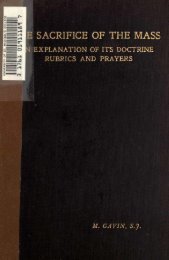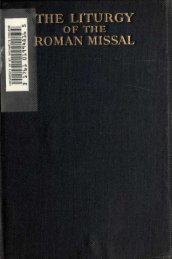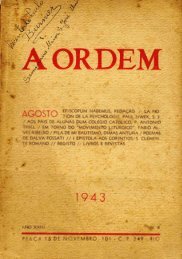E SACRIFICE OF THE MASS
E SACRIFICE OF THE MASS
E SACRIFICE OF THE MASS
Create successful ePaper yourself
Turn your PDF publications into a flip-book with our unique Google optimized e-Paper software.
<strong>THE</strong> VESTMENTS. ig<br />
that in use now. It completely covered the body the<br />
only aperture was at the top for the head. In the<br />
eleventh century the shape was altered and the sides<br />
were opened. It then took the form of a Gothic chasuble.<br />
This shape was preserved until the sixteenth century.<br />
After that time the chasuble was further cut away<br />
until it reached its present shape. On the face of the<br />
Roman chasuble we have the cross, on the back the<br />
column, though sometimes in the Roman vestment<br />
there is a cross also on the back.<br />
Originally there can be no doubt the chasuble was the<br />
garment worn over other clothes, and corresponding to<br />
what we call an overcoat. The Romans wore a large<br />
outer garment on military service, called the paenula or<br />
mantle. In the first half of the sixth century we find<br />
the first traces of the paenula as an ecclesiastical<br />
garment. Did it at once become distinctive of the<br />
priesthood ? The question<br />
admits of no certain answer.<br />
(Cath. Diet. p. 162.)<br />
The priest, while putting on the chasuble, says :<br />
D online qui dixisti jugum meum suave est et onus meum leve,<br />
fac ut istud port are sic valeani quod consequav tuani gvatiam<br />
" O<br />
Lord, who hast said, My yoke is sweet and My<br />
burden is light, grant me so to bear Thy yoke that<br />
I may obtain 1<br />
Thy grace."<br />
The veil covers the chalice. The burse holds the<br />
corporal, and is in shape like a square envelope. The<br />
because on it<br />
corporal, so-called from corpus (a body),<br />
rests the Body of the Lord after the consecration, is<br />
a square piece of linen with a cross in the centre.<br />
The pall is a linen covering on the top of the chalice<br />
1 As there is no necessary connection between the various<br />
prayers just quoted and the vestments, no attempt has designedly<br />
been made to explain the meaning of these prayers.






